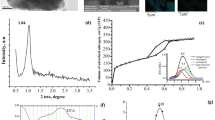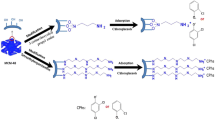Abstract
Cationic polyelectrolyte, PDDA (Poly(diallyldimethylammonium chloride)), was impregnated on mesoporous silica SBA-15 (PDDA/SBA-15) and amorphous conventional silica (PDDA/CS) supports. Acid dye adsorption characteristics, such as adsorption kinetics, adsorption isotherms, maximum adsorption capacity, and breakthrough curves of the prepared PDDA/SBA-15 and PDDA/CS adsorbents, were examined by batch and column adsorption techniques where the Acid Violet 17, Acid Red 44, and Acid Blue 45 were used as target adsorbates. PDDA/SBA-15 adsorbent showed fast adsorption kinetics of less than 10 min and much higher adsorption capacities compared to PDDA/CS due to large pore sizes, ordered cylindrical pore structures, and high amount of impregnated PDDA. Results from batch and column experiments showed that practical use of PDDA/SBA-15 adsorbent for effective removal of acid dyes from aqueous solution would be possible. Polyelectrolyte impregnation method was suggested as a simple method for the development of adsorbent with large pore diameters and efficient adsorption characteristics.
Similar content being viewed by others

References
Acemioglu, B., “Adsorption of Congo Red from Aqueous Solution onto Calcium-rich Fly Ash,”Journal of Colloid and Interface Science,274, 371 (2004).
Al-Ghouti, M.A., Khraisheh, M.A.M., Allen, S. J. and Ahmad, M.N., “The Removal of Dyes from Textile Wastewater: A Study of the Physical Characteristics and Adsorption Mechanisms of Diatomaceous Earth,”Journal of Environmental Management,69, 229 (2003).
Andreozzi, R., Caprio, V., Insola, A. and Marotta, R., “Advanced Oxidation Processes (AOP) for Water Purification and Recovery,”Catalysis Today,53, 51 (1999).
Andrzejewska, A., Krysztafkiewicz, A. and Jesionowski, T., “Adsorption of Organic Dyes on the Aminosilane Modified TiO2 Surface,”Dyes and Pigments,62, 121 (2004).
Arslan, I. and Balcioglu, I.A., “Degradation of Commercial Reactive Dyestuffs by Heterogeneous and Homogeneous Advanced Oxidation Processes: A Comparative Study,”Dyes and Pigments,43, 95 (1999).
Forgacs, E., Cserháti, T. and Oros, G., “Removal of Synthetic Dyes from Wastewaters: A Review,”Environment International,30, 953 (2004).
Garg, V.K., Kumar, R. and Gupta, R., “Removal of Malachite Green Dye from Aqueous Solution by Adsorption Using Agro-industry Waste: A Case Study ofProsopis cineraria,”Dyes and Pigments,62, 1 (2004).
Gulnaz, O., Kaya, A., Matyar, F. and Arikan, B., “Sorption of Basic Dyes from Aqueous Solution by Activated Sludge,”Journal of Hazardous Materials,B108, 183 (2004).
Han, S., Sohn, K. and Hyeon, T., “Fabrication of New Nanoporous Carbons through Silica Templates and Their Application to the Adsorption of Bulky Dyes,”Chem. Mater.,12, 3337 (2000).
Jesionowski, T., “Influence of Aminosilane Surface Modification and Dyes Adsorption on Zeta Potential of Spherical Silica Particles Formed in Emulsion System,”Colloids and Surfaces A: Physicochem. Eng. Aspects,222, 87 (2003).
Kang, T., Park, Y., Park, J. C., Cho, Y. S. and Yi, J., “Preparation of Chemically Active Mesoporous Adsorbent for Pt(II) and Pd(II) Adsorption from Aqueous Solutions,”Korean J. Chem. Eng.,19(4), 685 (2002).
Kim, Y., Kim, C., Kim, P., Park, J. C. and Yi, J., “Porous Alumina with Bimodal Pore Size Distribution as an Organic Adsorbent,” Adsorption Science and Technology, ed. Lee, C., World Scientific, Singapore, pp. 605–609 (2003).
Nakagawa, K., Namba, A., Mukai, S. R., Tamon, H., Ariyadejwanich, P. and Tanthapanichakoon, W., “Adsorption of Phenol and Reactive Dye from Aqueous Solution on Activated Carbons from Solid Wastes,”Water Research,38, 1791 (2004).
Park, J. C., Joo, J. B. and Yi, J., “Polyelectrolytes Impregnated Mesoporous Silica Adsorbents for the Adsorption of Anionic Dyes,”Water Research, accepted (2005).
Park, Y., Kang, T., Cho, Y. S., Park, J. C., Kim, P. and Yi, J., “Finely-Dispersed Ni/Cu Catalysts Supported on Mesoporous Silica for the Hydrodechlorination of Chlorinated Hydrocarbons,”Studies in Surface Science and Catalysis,146, 637 (2003).
Rajeshwarisivaraj, Sivakumar, S., Senthilkumar, P. and Subburam, V., “Carbon from Cassava Peel, and Agricultural Waste, as an Adsorbent in the Removal of Dyes and Metal Ions from Aqueous Solution,”Bioresource Technology,80, 233 (2001).
Tsai, W. T., Chang, C.Y., Ing, C.H. and Chang, C. F., “Adsorption of Acid Dyes from Aqueous Solution on Activated Bleaching Earth,”Journal of Colloid and Interface Science,275, 72 (2004).
Author information
Authors and Affiliations
Corresponding author
Rights and permissions
About this article
Cite this article
Park, J.C., Joo, J.B. & Yi, J. Adsorption of acid dyes using polyelectrolyte impregnated mesoporous silica. Korean J. Chem. Eng. 22, 276–280 (2005). https://doi.org/10.1007/BF02701497
Received:
Accepted:
Issue Date:
DOI: https://doi.org/10.1007/BF02701497



